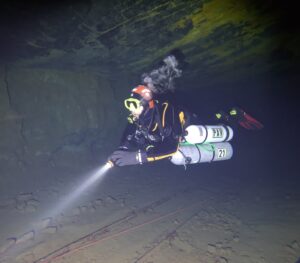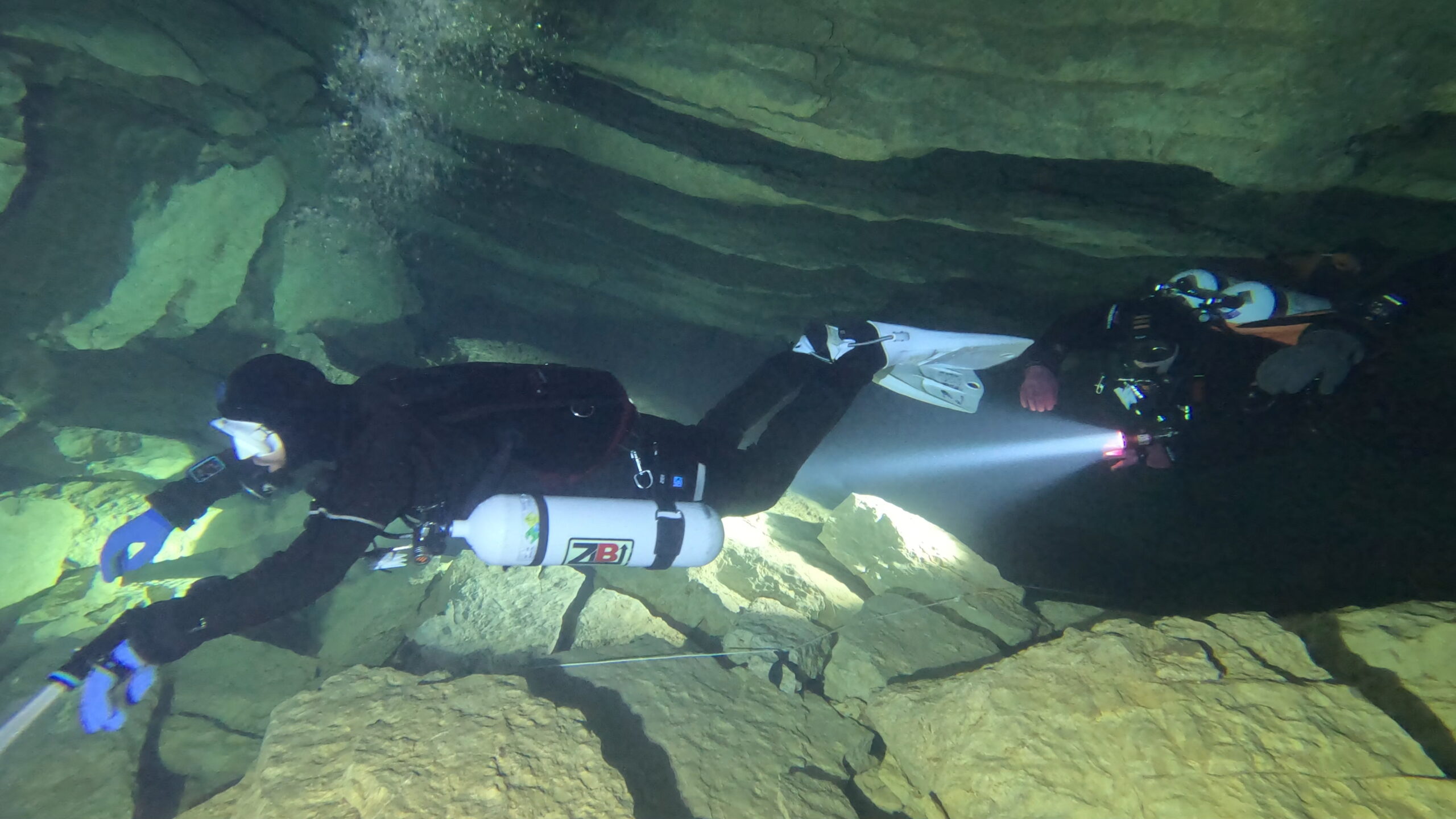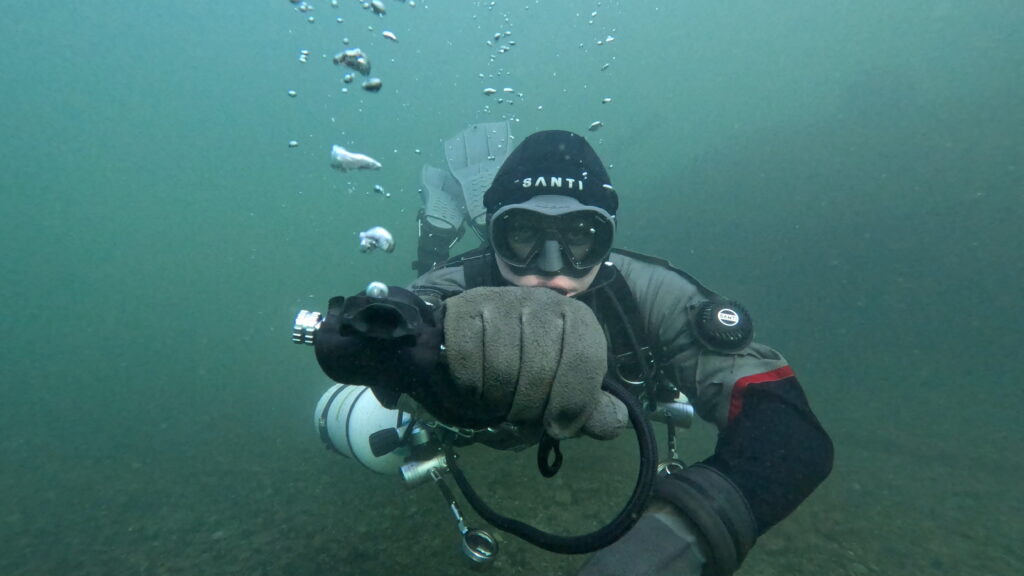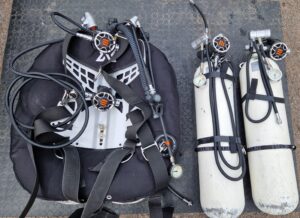Sidemount diving - history, configuration benefits
Diving in a sidemount configuration, also known as side-mount diving, is one of the fastest-growing styles of diving worldwide. Although it was initially used mainly by cave divers, today it has found its place in both technical and recreational diving. What exactly is sidemount, where did it originate, and what are its advantages and disadvantages? Here’s everything you need to know about side-mount diving.
History and Development of Sidemount: Beginnings in Caves
Sidemount was born in the 1960s among British cave divers. In the narrow and hard-to-reach corridors of underwater caves, the traditional backmount configuration (with tanks on the back) proved inadequate. Moving the tanks to the sides of the body allowed easier passage through tight spaces, enhancing mobility and safety.
Similar needs emerged in the 1970s among American cave divers in Florida. The underwater caves there are known for their complex topography, requiring greater flexibility and agility underwater. The sidemount configuration perfectly suited these requirements.


Development and Popularization of Sidemount
As technical diving grew in popularity, sidemount quickly gained recognition outside of caves. Technical divers appreciated numerous benefits, such as better buoyancy control, easier access to valves, and the ability to flexibly manage gas.
The growing popularity of sidemount led diving organizations to offer dedicated sidemount courses. This allowed more recreational divers to adopt this configuration, appreciating its versatility and convenience.
Benefits of Sidemount Diving
Sidemount offers a range of benefits that make it increasingly popular, not only in cave diving but also in recreational and technical diving. Here are the main advantages:
- Easy access to valves – Tanks mounted on the sides make valve handling simple and quick. Unlike backmount, where valves are behind the diver’s back, in sidemount, they are always within arm’s reach.
- Better buoyancy control – The ability to adjust the position of tanks and ballast system allows precise trim, which is crucial in demanding environments like caves or wrecks.
- Comfort in carrying equipment – Compared to backmount, sidemount is more ergonomic during transport, especially in challenging terrain conditions. It’s also a better option for individuals with physical limitations.
- Versatility and flexibility – The ability to quickly switch tanks, easily detach and reattach them underwater makes sidemount ideal for long dives or exploratory expeditions.

Disadvantages of the Sidemount Configuration
Of course, sidemount also has its drawbacks, which could be crucial when deciding whether to choose this diving style:
- Complexity of equipment – More components around the chest, such as tanks, bungee cords, hoses, and clips, can be confusing, especially for beginner divers.
- Limited access to drysuit pockets – The side-mounted tanks limit access to standard drysuit pockets, which can be inconvenient in some situations.
- Challenging gas management – Sidemount requires additional training, especially in terms of switching regulators, which can be challenging for less experienced divers.
- Potentially higher water resistance – Improperly configured tanks can increase drag, making it harder to move smoothly underwater.
Mexican vs. Florida Sidemount Configuration
There are two main schools of sidemount configuration that differ slightly in their approach to equipment and technique:
- Mexican Sidemount Configuration – This is more minimalist and used primarily in flooded cave systems on the Yucatan Peninsula. It features a smaller wing, a lighter harness, and closer tank mounting to the body, reducing drag and making it easier to navigate tight passages.
- Florida Sidemount Configuration – Primarily used in deep and complex caves in Florida. It features more advanced equipment, a larger wing, a sturdy harness with a hard plate, and tanks positioned slightly farther from the body for easier valve and equipment management.

Sidemount vs. Backmount – Which to Choose?
The choice between sidemount and backmount depends on the type of diving and individual preferences. Sidemount works best in situations where greater flexibility, easy access to equipment, and movement in tight spaces are needed. On the other hand, backmount is simpler to manage and better suited for traditional recreational diving.
Why Sidemount?
Sidemount is a unique configuration that excels in various types of diving, whether in open water or overhead environments like caves and wrecks. It works well in both open circuit (OC) and closed circuit (Kiss Sidewinder) setups, making it an extremely versatile choice for divers of different preferences and experience levels.
Meets All the Requirements of a Proper Configuration
Sidemount stands out by combining key features of an ideal diving configuration:
- Functionality – Easier access to valves, convenient tank management, and flexibility in adapting to different conditions make sidemount an exceptionally functional solution.
- Comfort – The balanced distribution of weight and lack of back-mounted gear provide greater comfort during long dives and better mobility, which is especially important in confined environments.
- Simplicity – Although the side-mount configuration may initially seem complex, it’s designed to be straightforward, especially with proper training. The minimalist setup and clear hose organization allow quick mastery of the technique.
- Safety – The ability to quickly check and adjust valves and easily manage gas makes sidemount one of the safest options, particularly in technical and cave diving.
Sidemount is gaining popularity not only because of its functional benefits but also because it gives divers greater control over their equipment and comfort. It’s a versatile solution that meets all the key requirements for safe and effective diving, regardless of conditions or environment.
Sidemount Course – What You Need to Know
To start your sidemount journey, you need to meet a few requirements. First, you should have a minimum of 30 logged dives and be certified at the Open Water Diver level. The sidemount course includes both theoretical and practical sessions, where you’ll learn equipment handling, buoyancy control, and emergency procedures specific to this configuration.
Summary
Sidemount diving is not just a modern alternative to traditional backmount but primarily an effective tool in demanding environments. Thanks to its versatility and flexibility, sidemount is becoming increasingly popular among both technical and recreational divers. If you’re looking for new challenges and want to expand your skills, consider taking a sidemount course and experience diving from a new perspective.
